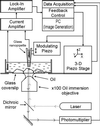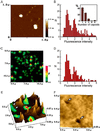Scanning surface confocal microscopy for simultaneous topographical and fluorescence imaging: application to single virus-like particle entry into a cell
- PMID: 12466501
- PMCID: PMC138557
- DOI: 10.1073/pnas.252458399
Scanning surface confocal microscopy for simultaneous topographical and fluorescence imaging: application to single virus-like particle entry into a cell
Abstract
We have developed a method for simultaneous recording of high-resolution topography and cell surface fluorescence in a single scan which we call scanning surface confocal microscopy. The resolution of the system allows imaging of individual fluorescent particles in the nanometer range on fixed or live cells. We used this technique to record the interaction of single virus-like particles with the cell surface and demonstrated that single particles sink into the membrane in invaginations reminiscent of caveolae or pinocytic vesicles. This method provides a technique for elucidating the interaction of individual viruses and other nanoparticles, such as gene therapy vectors, with target cells. Furthermore, this technique should find widespread application for studying the relationship of fluorescently tagged molecules with components of the cell plasma membrane.
Figures




Similar articles
-
Analysis of virus entry and cellular membrane dynamics by single particle tracking.Methods Enzymol. 2012;506:63-80. doi: 10.1016/B978-0-12-391856-7.00028-7. Methods Enzymol. 2012. PMID: 22341219 Review.
-
Total internal reflection microscopy for live imaging of cellular uptake of sub-micron non-fluorescent particles.J Microsc. 2008 Jul;231(Pt 1):168-79. doi: 10.1111/j.1365-2818.2008.02027.x. J Microsc. 2008. PMID: 18638200
-
Combined AFM and confocal fluorescence microscope for applications in bio-nanotechnology.J Microsc. 2005 Jan;217(Pt 1):109-16. doi: 10.1111/j.0022-2720.2005.01428.x. J Microsc. 2005. PMID: 15655068
-
High speed unsupervised fluorescence lifetime imaging confocal multiwell plate reader for high content analysis.J Biophotonics. 2008 Dec;1(6):514-21. doi: 10.1002/jbio.200810054. J Biophotonics. 2008. PMID: 19343677
-
Light microscopy techniques for live cell imaging.Science. 2003 Apr 4;300(5616):82-6. doi: 10.1126/science.1082160. Science. 2003. PMID: 12677057 Review.
Cited by
-
Endocytic pathways: combined scanning ion conductance and surface confocal microscopy study.Pflugers Arch. 2008 Apr;456(1):227-35. doi: 10.1007/s00424-007-0410-4. Epub 2008 Jan 5. Pflugers Arch. 2008. PMID: 18180951 Free PMC article.
-
Role for centromeric heterochromatin and PML nuclear bodies in the cellular response to foreign DNA.Mol Cell Biol. 2006 Apr;26(7):2583-94. doi: 10.1128/MCB.26.7.2583-2594.2006. Mol Cell Biol. 2006. PMID: 16537904 Free PMC article.
-
Correlative 3D microscopy of single cells using super-resolution and scanning ion-conductance microscopy.Nat Commun. 2021 Jul 27;12(1):4565. doi: 10.1038/s41467-021-24901-3. Nat Commun. 2021. PMID: 34315910 Free PMC article.
-
Receptor trafficking and AFM.Pflugers Arch. 2008 Apr;456(1):189-98. doi: 10.1007/s00424-007-0380-6. Epub 2007 Nov 16. Pflugers Arch. 2008. PMID: 18008083 Review.
-
Nanoscale live-cell imaging using hopping probe ion conductance microscopy.Nat Methods. 2009 Apr;6(4):279-81. doi: 10.1038/nmeth.1306. Epub 2009 Mar 1. Nat Methods. 2009. PMID: 19252505 Free PMC article.
References
-
- Chimini G. & Chavrier, P. (2000) Nat. Cell Biol. 2, E191-E196. - PubMed
-
- Sieczkarski S. B. & Whittaker, G. R. (2002) J. Gen. Virol. 83, 1535-1545. - PubMed
-
- Zabner J., Fasbender, A. J., Moninger, T., Poellinger, K. A. & Welsh, M. J. (1995) J. Biol. Chem. 270, 18997-19007. - PubMed
-
- Bartlett J. S. & Samulski, R. J. (1998) Nat. Med. 4, 635-637. - PubMed
Publication types
MeSH terms
Substances
LinkOut - more resources
Full Text Sources
Other Literature Sources
Miscellaneous

